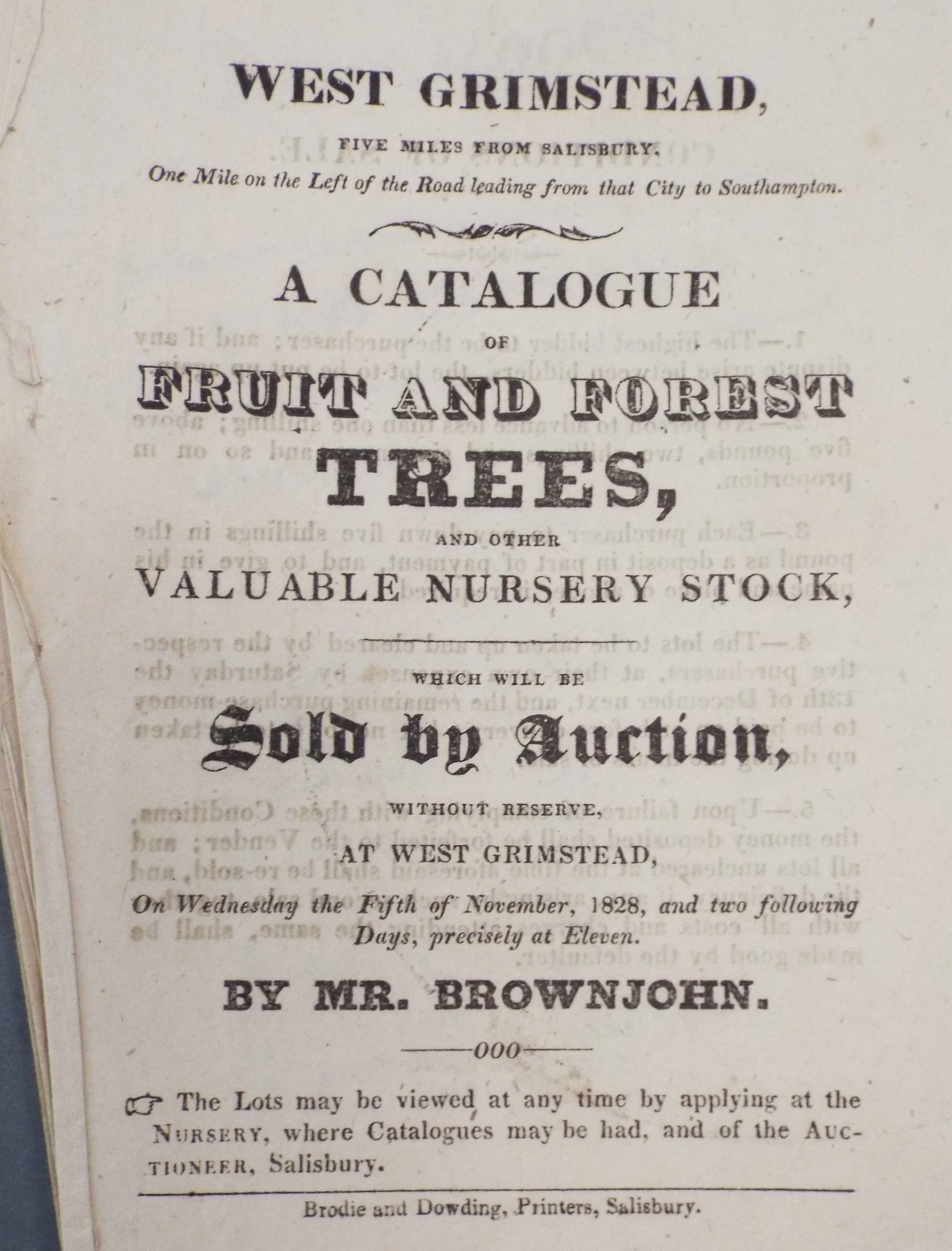An Early 19th Century Plant Catalogue: The West Grimstead Nursery Sale of 1828
The first garden centre to open in England is generally held to be the Royal Horticultural Society's garden shop which opened in London in 1860. Before this date nurseries were established to supply market gardens, landed estates and larger houses. For estate redevelopment an area might be set aside as a nursery for several years with the surplus stock sold once the project was complete.
Horticulture was a significant component of the rural economy from the 17th century. Often local histories remark upon the substantial amount of market gardening which supported larger towns but say little of the nursery gardens. While both forms of gardening took place at the same time, the nursery gardens evolved to meet changing markets. These gardens produced catalogues (there are examples from more than 3000 firms in the RHS library). Trade lists as independent publications in book form began to appear in the 18th century. These lists simply listed the names of the plants until the middle of the 19th century and only in 1860 did they begin to include illustrations and detailed descriptions.
At West Grimstead we find a particularly comprehensive sale catalogue produced by the auctioneer Mr Brownjohn for stock was to be sold in November 1828. On the first day there were 250 lots. The first 37 were of standing, hedgerow and coppice trees: two lots of silver fir (36 and 66 trees each 3 feet high), one lot of English oak (2000 trees each 2 feet high), 18 lots of hazel (each lot of 2000 trees, 2 feet high), 15 lots of seedling crab apples, each lot comprising between 700 and 2500 trees, and 700 beech at 4½ feet.
Following the hedgerow and coppice trees were a range of fruit trees in which each lot comprised a mix of standard, dwarf and trained plants. Presumably the latter two categories intended for ornamental rather than market gardens. First were the pear trees, 11 varieties in separate lots; then plums, 10 varieties in 15 lots; nectarines, 8 varieties in 16 lots; peach, 15 varieties in 25 lots; apples, 18 varieties in 36 lots. Perhaps surprisingly most of the apples can be easily identified: all of the pippins Grumage (now better known as Birmingham), Kerry, Kentish and Ribstone, the russets, Caraway, Large [Jersey] and Pyle, as well as Deux Ans, Golden Ducket (i.e. Dukat), Nonpariel, Pomeroy, Rather (i.e. Rathe) Ripe and Summer Pearmain, can be found on modern listings. Shepherd's Incomparable was perhaps a variety linked to Shepherd's Fame and only Green Blandren can not be traced in modern catalogues and indexes.
Then came lots of mixed roses, sold in rows each containing between 6 and 100 plants, ornamental and non-native fruit trees including peach, nectarine, green gage, plum and apricot, and small standing and hedgerow trees: spruce, oak, laurel, holly, bay, privet, phillyrea, sold in rows. The next lots were the soft fruit, black, red and white currants and gooseberries, also sold in rows, beds of three year old asparagus, and some more ornamental trees such as weeping willow, plane and lime.
The second day of the auction contained more rows of fruit, hedgerow and coppice trees as well as some ornamental plants. Cypress and Virginia Cedar were sold in pots, there were lots of clematis and honeysuckle. For the market gardeners and kitchen gardens there were more lots of asparagus, apricot, cherry and pear.
The third and final day of the sale was dominated by coppice, hedgerow and standing trees: Alder, mountain and weeping Ash, beech, horse and Spanish chestnut, elm, fir, hornbeam, oak, pine, poplar, spruce, sycamore. Thorn plants, presumably for hedgerows, were sold in 25 lots, each containing 6000 plants in four rows. There were also ornamental plants: andromeda, azalea, hydrangea, japonica and several varieties of rhododendrons.
Who did this enormous range of plants come to be cultivated at West Grimstead? The nurseryman is not named in the catalogue and the number of lots is too large for a regular annual auction. The presence of such a large stock of fruit and forest trees and nursery stock at West Grimstead coincided with the redevelopment of the earl of Radnor's Longford Castle estate. The formal gardens at Longford designed by Lancelot 'Capability' Brown had been removed by the late 18th century and plans had been made to remodel the existing gardens and the park which extended into land newly acquired at Alderbury meadow. A walled garden supplying fruit and vegetables to the Castle kitchen was constructed at around the same time. It seems most likely that the plants sold at auction in 1828 were surplus stock grown by the nurseryman for the earl of Radnor.
Garden historians have tended to concentrate on garden design, although there have been several recent journal articles relating to nurseries the standard works remain John H Harvey's Early Gardening Catalogues (1972) and Early Nurserymen (1974).
Mark Forrest

